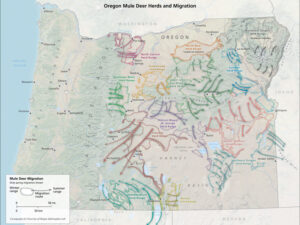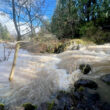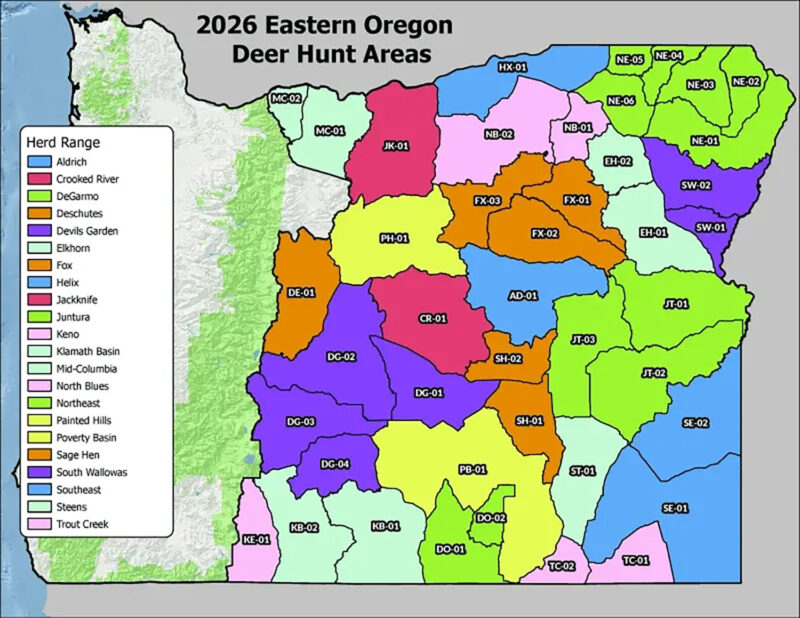Mule deer hunts in Eastern Oregon in 2026 will be structured based on herd ranges, not wildlife management units, state Fish and Wildlife Commission members decided Sept. 12.
WMUs have been used to structure Oregon’s big game hunts and collect population data since the 1950s. Based on conventional wisdom about animal distributions and movements at that time, WMUs were used primarily for managing hunter distribution. Easily recognized landmarks and socio-political boundaries were used as boundaries for ease in identification.
Extensive research using GPS-collared deer has shown that WMUs rarely contain all the resources a deer herd needs in a year. For example, many animals within a herd spend summer/early fall (when they are harvested by hunters) in different WMUs than during winter (when they are counted by ODFW).
Based on the movements from over 1,400 mule deer collared in recent years, ODFW has identified 22 distinct mule deer herd ranges in eastern Oregon. A mule deer “herd range” includes the entire area a herd uses in a year, including summer ranges, winter ranges, and the migration corridors between them. These ranges now form the basis for ODFW’s mule deer monitoring and management, including harvest management.
ODFW’s improved, stronger population models now integrate multiple data streams, including herd composition (buck and doe ratios) and abundance data. To function properly, these models also require accurate harvest data to be collected within a herd range, which is difficult with the current WMU hunt structure.
 To address this misalignment, ODFW will transition mule deer hunting from WMUs to new Deer Hunt Areas within herd ranges in 2026. Commissioners were told that this change will better align hunting effort and associated harvest with Oregon’s mule deer populations and management goals, improve monitoring of population trends, and allow for quicker management responses/accurate evaluation of management actions.
To address this misalignment, ODFW will transition mule deer hunting from WMUs to new Deer Hunt Areas within herd ranges in 2026. Commissioners were told that this change will better align hunting effort and associated harvest with Oregon’s mule deer populations and management goals, improve monitoring of population trends, and allow for quicker management responses/accurate evaluation of management actions.
Many hunters likely won’t see significant impacts to their hunt except for a hunt name change. In other areas, boundaries for new hunts will be different than past hunts.
Tag numbers will change slightly to manage hunter pressure and numbers could fluctuate over the next few years as hunters and ODFW adapt to these new hunt areas. All the areas that have been open to deer hunting will remain open.
There is also no change to the preference point system under the new hunt structure. But, as always when there are new hunts, hunters should expect a period of uncertainty regarding how many hunters choose to put in for a hunt and the number of preference points needed to draw a tag for a given hunt area. Hunters will want to be aware of this uncertainty when deciding how to use preference points over the next few years.
Hunters are encouraged to visit the MyODFW.com Eastern Oregon Deer Hunting page at myodfw.com/articles/eastern-oregon-deer-hunts for more information, including maps showing old vs new hunt boundaries.
In other action, the commission:
- Voted to open a hatchery Chinook salmon season in the Coquille River, the first Chinook season since 2021, during their meeting Sept. 12 in Ontario. The Coquille River will be open for fall salmon fishing from Sept. 13 to Oct. 15 from the Hwy 101 bridge upstream to the Hwy 42S Sturdivant Park Bridge near the town of Coquille. The daily bag limit is two adult salmon (hatchery Chinook and coho, but only one may be a wild coho) with a season limit of three wild coho.
- Approved spearfishing in rivers and streams that are open with no limit for bass and walleye. Anglers have been requesting expanded opportunity to spearfish for bass and walleye, a popular alternative fishing method that may also help to reduce impacts of bass and walleye on native fish. Spearfishing for bass and walleye would be allowed in the Willamette River downstream of reservoirs but not in the reservoirs, with the exception of Foster Lake.
- Approved the fishing for coho salmon in the South Santiam between Jan. 1 and Aug. 1 and Oct. 15 through Dec. 31 between Waterloo Bridge to 200 feet above Waterloo Falls.
- Approved fishing for coho salmon in the mainstem Willamette River between the Hwy. 20 bridge and the Hwy. 99 bridge between Oct. 1 and Dec. 31, due to increased coho populations in the upper Willamette Basin.
- Approved changes to the kokanee bag limit in an effort to clearly separate it from the trout limit. Beginning in 2026, the kokanee bag limit will be 10 per day, open all year with no size limit (unless noted under Exceptions). The change removes the confusing bonus bag limit and replaces it with a standard kokanee specific limit.
- Banned the use of dead aquaria species fish because aquaria (those kept as pets in tanks) fish are not screened for pathogens that may affect native or other game fish in waterbodies may be transmitted if dead aquaria fish are used as bait.
- Approved fishing for crayfish all year in streams or lakes, including those listed as closed. The change clarifies the current regulation that can be misinterpreted as inadvertently restricting crayfishing to streams and not open to lakes or not open all year to lakes.
- Approved the use of spring (basket/cage) type feeders for carp fishing. Fishing for carp is increasingly popular, but the use of spring feeders, a common method when targeting carp, was not allowed under previous regulations.
- Approved a fee change for ocean anglers: Starting Jan. 1, 2026, anglers will need an Ocean Endorsement ($9 annual/$4 daily) to fish for all marine fish species (except for shellfish, salmon and steelhead) in ocean waters. The 2025 Oregon State Legislature approved this endorsement to specifically fund fish population surveys and research in Oregon’s state waters. More nearshore fish population surveys are important because they give scientists assessing populations more confidence in their models, so there is better data informing management decisions.
- Approved an updated “Greater Sage-Grouse Conservation Assessment and Strategy for Oregon” and amended associated rules as proposed by staff. The plan provides greater clarity on ODFW’s approach to sage-grouse management. It emphasizes the biggest threats to sage-grouse in Oregon (fire, invasive annual grasses, and conifer encroachment) and includes an improved population model to help track population abundance and trends and updated Core and Low-Density Habitat maps.





